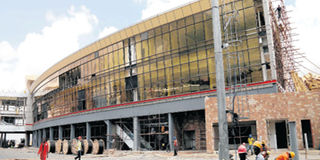Kenya Airways to soar higher with first Dreamliner jet

A section of the JKIA Terminal 4 that is under construction. Kenya Airways will this week receive its first Dreamliner aircraft. PHOTO | SALATON NJAU
What you need to know:
- The company embarked on Project Mawingu — a 10-year plan until 2022 —- in 2012, focusing on increasing capacity in a bid to turn around the airline’s financial fortunes and boost its market share of regional air traffic.
- Like other airlines, Kenya Airways has been attracted by Dreamliner’s advantages such as more cargo space and greater fuel efficiency, achieved by increased use of lighter plastic materials in place of metals.
Kenya Airways will this Friday receive its first Dreamliner jet, keeping the company on track in its ongoing fleet expansion drive expected to almost triple its capacity in 10 years.
The new aircraft, the first of nine such jets the national carrier is set to receive from Boeing Company by July 2015, will touch down at the Jomo Kenyatta International Airport at 3pm, signifying the beginning of the second phase of the airline’s Mawingu expansion strategy.
“The next delivery shall be July, then August, September, and a final one for this year in October before we take a break until next year,” the KQ chief executive officer, Mr Titus Naikuni, told Smart Company in an interview.
The company embarked on Project Mawingu — a 10-year plan until 2022 —- in 2012, focusing on increasing capacity in a bid to turn around the airline’s financial fortunes and boost its market share of regional air traffic.
Under the project, the national carrier intends to expand its fleet to 119 aircraft from the current 44 and its network coverage from 58 to 115 routes by the end of 2021. The airline’s management said focus will be on growing the number of destinations in the Far East and new markets. It plans to launch seven new routes into China, six in the Indian sub-continent, and three across north and southeast Asia.
With an already growing presence in Europe and the Middle East, Kenya Airways targets to become Africa’s largest carrier and one of the few airlines to serve every continent.
Mawingu was based on two key premises; the delivery of state-of-the-art jets for both long and short/medium haul and the timely completion of the expansion project by the Kenya Airports Authority.
The expansion project is on course and involves the construction of a second runway at JKIA and a new mega terminal, increasing the airport’s capacity fivefold from the present 7-plus million passengers.
TECHNICAL SETBACKS
“The latest update from the Kenya Airports Authority is that Terminal Four shall become operational by July and a new arrivals terminal shall be ready by the end of the year… this points to great improvement,” said the airlines’ chief operating officer, Mr Mbuvi Ngunze.
The Dreamliner model was grounded by battery problems in 2012 and has suffered a number of other technical setbacks since introduction but Mr Naikuni expressed confidence in its safety.
“Our teams have so far visited other operators with the Dreamliner and I can say we have 98 per cent confidence level in its safety,” he said, adding that much of the earlier problems have been resolved in subsequent planes.
He said the B787 Dreamliner’s first assignment would be the Nairobi-Paris route as the airline looks to expand European routes currently being served by its ageing Boeing 767s. The airline has, however, set aside two months to familiarise its pilots and crew on the operations of the new plane before its maiden commercial flight in July.
Like other airlines, Kenya Airways has been attracted by Dreamliner’s advantages such as more cargo space and greater fuel efficiency, achieved by increased use of lighter plastic materials in place of metals.
The 787-8 model picked by the national carrier uses 20 per cent less fuel and has the capacity to carry between 210 and 250 passengers on routes of between 14,200km and 15,200km.
Fuel costs account for more than half of KQ’s direct operating costs and the airline is keen on cutting its expenses to grow profits.
The arrival of the new bird follows hot on the heels of the start of Kenya Airways’ low cost airline, Jambojet, which is due to launch flight operations on April 1, flying from Nairobi to Mombasa five times a day.
Other destinations for Jambojet are Kisumu (twice a day) and Eldoret (10 times a week), effectively taking over much of the present domestic network of the national carrier.
“We are pleased to be using Dreamliner for our expansion plans, which will be both more environment-friendly and economical as we embrace the benefits of its design,” said Mr Naikuni who is set to leave the airline in November after a decade at the airline.
FLEDGLING AIRLIE
Mr Naikuni, who took over the helm of the airline in 2003, has spearheaded one of the most significant expansions of an African airline, perhaps only rivalled by Ethiopian Airlines, which is sponsored by its government. He has led the national carrier from a fledgling airline with 25 aircraft hauling about 1.4 million passengers annually between Africa and Europe. The airline now has 45 planes ferrying 1.9 million passengers a year.
Mr Naikuni initially joined KQ as a board member in August 1999 as a member of the “dream team” – group of technocrats that former president Moi’s government hired with World Bank sponsorship to turn around the economy.
He had served as the permanent secretary in the Ministry of Information, Transport and Communication – which gave him a seat in KQ’s board where he served until he resigned on April, 2001 only to return two years later as managing director.
His long association with KQ has made him synonymous with the face of the national carrier.




